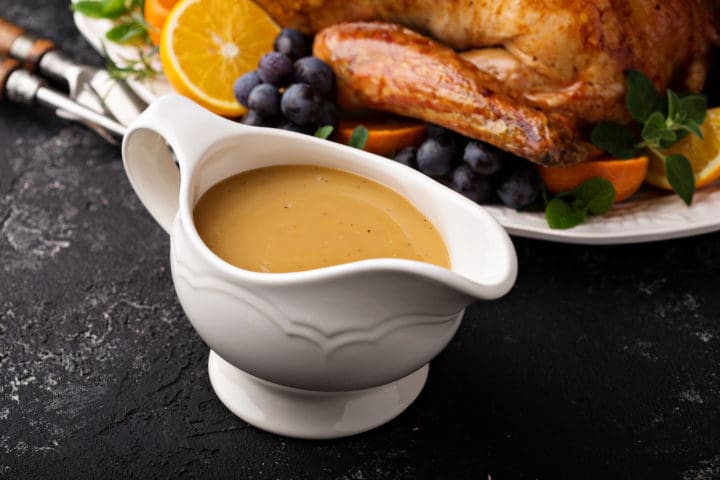Best Way to Thicken Gravy Thanksgiving Turkey Problems
Best Way to Thicken Gravy
Watery gravy is not at all appetizing. I like gravy to be thick and not run all over my plate. However, I also don't like my gravy-like paste. I am eating food and not hanging wallpaper. You can thicken most sauces and gravies with some sort of starch.
Several of the common starches are listed above along with some uncommon starches. Everyone has their favorites and often it is just a matter of preference. The key is choosing the right thickener and adding it the right way. We hope that this Best Way to Thicken Gravy post inspires you.

Image from Depositphotos
Best Way to Thicken Gravy
There are a few ways to thicken gravy, each with its advantages and considerations. While you can add a thickener directly to your gravy, oftentimes you will end up with lumps. There are several things that you can do to prevent lumps including whisking constantly when adding a thickener.
Reducing the liquid
This method involves simmering the gravy uncovered, allowing the excess liquid to evaporate and concentrate the flavors.
- Pros: Simplest method, enhances the flavor as it thickens.
- Cons: Takes the longest time and requires attention to prevent burning.
- Tips: Simmer the gravy over low heat, stirring occasionally, until it reaches the desired consistency.
Get Thanksgiving Delivered from Boston Market
Using a Slurry
The easiest method to thicken gravy is with a slurry. Mix cornstarch into a small amount of cold water or stock and then whisk this into a simmering sauce. This will cause your gravy to thicken instantly. You can use this same method for most starches but be careful not to use too much or overheat the sauce. Too much heat will cause your sauce to thin out considerably.
- Mix a thickening agent: In a small bowl, whisk together 3-4 tablespoons of flour or cornstarch with a little cold water until a smooth paste forms.
- Gradually add to gravy: Slowly whisk the slurry into your simmering gravy, a little at a time, until it reaches your desired thickness. Let the gravy simmer for a minute or two between each addition to allow it to thicken fully.
- Be mindful of the amount: Adding too much slurry can make your gravy heavy or gluey, so start with a small amount and adjust gradually.
For a medium-thick sauce or gravy, add about 2 tablespoons of flour per cup of liquid. If using potato starch, arrowroot, or tapioca, use about half as much. If you're using cornstarch, use about 2 to 2 1/2 teaspoons per cup.
Thanksgiving Mistakes Cooks Make
Common Thickeners
- cornstarch
- cold water
- extra virgin olive oil
- flour
- cream
Not So Common Thickeners
- Instant mashed potatoes – dry – they add creaminess too!
- Arrowroot
- Tapioca Flour
- Mashed vegetables: If you're making vegetable gravy, you can mash some of the cooked vegetables and stir them back into the gravy for added thickness and flavor.
- Xanthan gum: This gluten-free option requires only a small amount (around 1/4 teaspoon) to thicken liquids. However, it can be tricky to use, so start with a very small amount and whisk it in gradually to avoid over-thickening.

Image from Depositphotos
Make a Roux
While making a roux is the most time-consuming, making a roux of olive oil, flour salt & pepper to taste is a way to thicken gravy and have it still taste amazing. As a bonus, there will be NO lumps.
- Melt fat: In a saucepan over medium heat, melt butter or oil.
- Cook flour: Add an equal amount of flour to the melted fat and whisk constantly until there are no lumps and the mixture turns golden brown.
- Incorporate into gravy: Slowly whisk the roux into your simmering gravy until it reaches your desired consistency.
Emeril's Roux: In a saute pan, add 1 cup of olive oil. When the pan is incredibly hot, whisk in flour. Then reduce the heat. Season with salt and pepper. Stir the mixture constantly for 30 minutes or dark brown with a nutty aroma. Remove from heat.
Turkey Casserole Leftovers Recipe
Tips for Thickening Gravy
- Simmer, don't boil: Avoid boiling your gravy after adding thickeners, as this can cause it to thin out again.
- Taste as you go: Keep tasting your gravy as you thicken it to ensure you don't overdo it. You can always add more thickener, but you can't easily remove it once added.
- Begin small: Start with a small amount of thickener and add more gradually until you reach the desired consistency.
- Check texture: Don't over-thicken your gravy, as it can become gluey and lose its flavor.
- Smooth the lumps: If you do end up with lumps in your gravy, you can try using an immersion blender to smooth them out.
Best Way to Thicken Gravy
The best method for thickening your gravy will depend on your personal preference and the ingredients you have available. By following these tips and choosing the method that suits your needs, you can achieve a perfectly thickened and delicious gravy. We hope that this Best Way to Thicken Gravy post inspires you. Happy cooking!

Healthy Crock Pot Beef Stew
You May Also Like








I’ve never thought of using olive oil or instant mashed potatoes.
Me either on the mashed potatoes. I would have never considered but I saw it online when researching this article. Thanks for stopping by!
thanks I needed these gravy thickening tips, somehow I just can’t get the basics of gravy…
Pingback: Easy Slow Cooker Beef Stew with Root Vegetables Recipe
Pingback: Ultimate Thanksgiving Planning Guide Divine Lifestyle
Pingback: Best Side Dishes for Thanksgiving Unique Sides